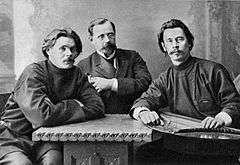Konstantin Pyatnitsky
| Konstantin Petrovich Pyatnitsky | |
|---|---|
 Pyatnitsky (middle) with Maxim Gorky (right) and Stepan Skitalets, 1902 | |
| Born |
Константин Петрович Пятницкий 31 March 1864 Novgorod Governorate, Russian Empire |
| Died |
6 January 1938 (aged 73) Leningrad, USSR |
| Occupation | publisher, editor, memoirist |
| Years active | 1890s-1930s |
Konstantin Petrovich Pyatnitsky (Russian: Константин Петрович Пятницкий, 31 March 1864, v. Kemtsy, Valdai Region, Novgorod Governorate, Russian Empire, - 6 January 1938, Leningrad, USSR) was a Russian journalist, publisher and memoirist. Pyatnitsky was a co-founder of Znanie and one–time close associate of Maxim Gorky.[1][2]
Biography
Konstantin Pyatnitsky was born in the Novgorod region of Russia, in the family of a local priest. After the graduation in 1888 from the Kazan University he moved to Saint Petersburg and joined the Committee for Literacy (1892-1895) and also the staff of Mir Bozhy magazine (1893-1896).[1]
In 1898 Pyatnitsky founded Znanye publishing company and became its executive director and editor. In 1900 he invited Maxim Gorky to join Znanie publishing company and found himself under the latter's strong influence. He signed an agreement with the communists' RSDRP party which obliged Znanie to publish the Marxists materials. In 1909, facing prosecution, Pyatnitsky left Russia. He returned in 1913, but a year before Gorky, disillusioned with what he saw as Znanye's more conservative politics, left the company.
After the 1917 Revolution Pyatnitsky served as a director of the House of Science's library. In 1919 he handed off 250 thousand book copies from the Znanye storehouses to the Bolshevik Ministry of Education. In 1937 he published a book of memoirs called M. Gorky Back Home (М. Горький на родине, Gorky).[2]
References
- 1 2 Tchuvakov, V.N. "Konstantin Petrovich Pyatnitsky". The Brief Literary Encyclopedia. 1971. Vol.VI. Retrieved 2014-01-13.
- 1 2 Golubeva, O.D. "Konstantin Petrovich Pyatnitsky". Zvezda, 1938. No.10 // Ruskaya Literatura, 1972 No. 2. Retrieved 2014-01-13.